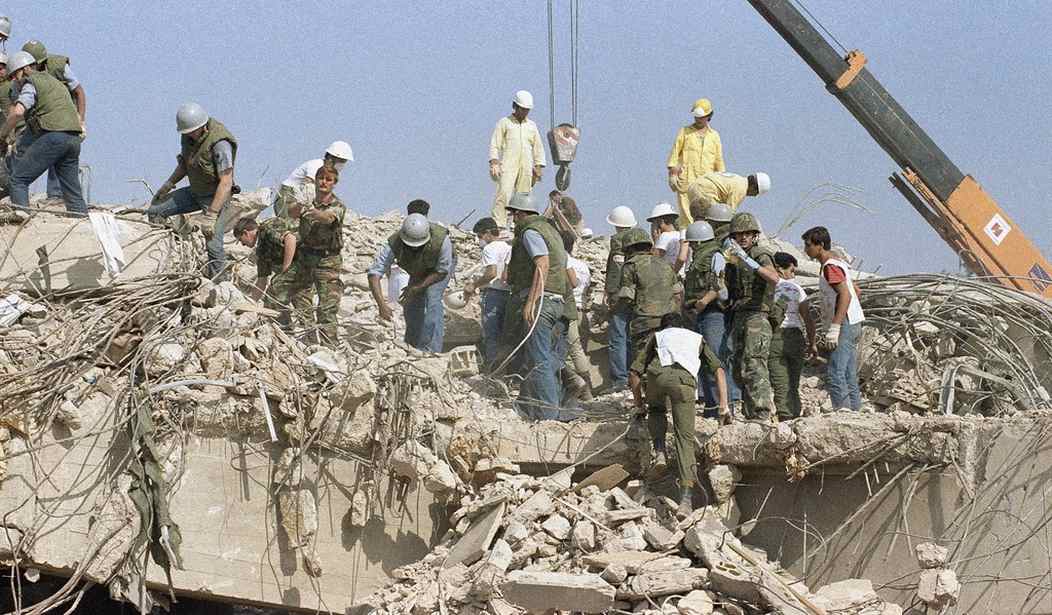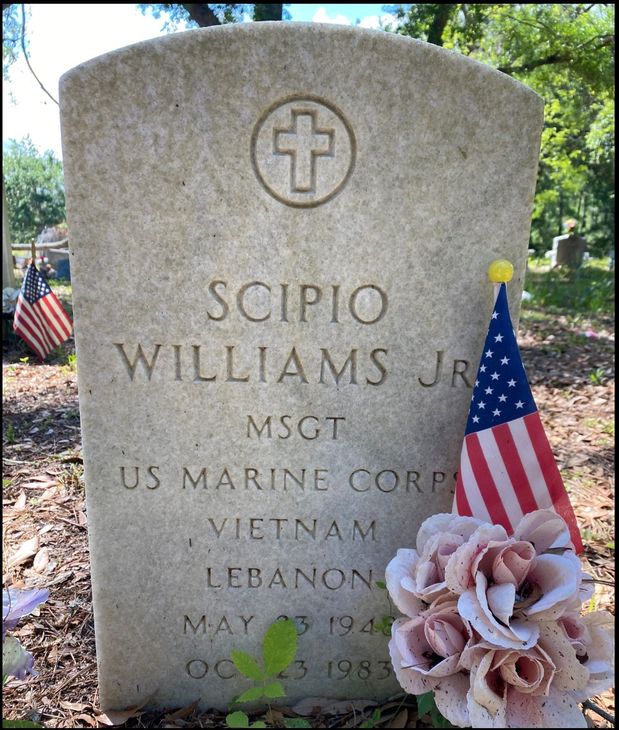Top News
40 Years After The Marine Barracks Bombing: We Have Sacrificed To These Savages Before

THEY CAME IN PEACE
The local residents have been slaughtering each other for centuries on that little slice of Mediterranean coastline from Lebanon to Gaza. This killing spree was no different, except, this time, the United States Marines were sent in. Not as avenging angels, but to keep the warring factions apart.
In August 1982, the governments of the United States, France, Italy, and Great Britain deployed a multinational peacekeeping force to Lebanon in an effort to stabilize the country and stop the fighting between Syria, the Palestine Liberation Organization (PLO), and Israel. The contingency—including the first 800 U.S. Marines from the 32nd Marine Amphibious Unit (MAU)—agreed to oversee the PLO’s evacuation and by 10 September through high-level diplomacy, the PLO left the port of Beirut. The Marines departed as well considering the mission complete. Just four days later, the president-elect of Lebanon, Bashir Gemayel, was assassinated. In response, elements of Lebanese forces avenged his death by massacring more than 1,000 unarmed Palestinians. Lebanon was once again in chaos. The multinational force was ordered back to Beirut, and by 29 September, elements of 32nd MAU had landed for a second time.
Initially, the multinational force’s mission was to establish a presence in Beirut providing the stability necessary for the Lebanese government to regain control of the capital city and train the Lebanese armed forces to become strong enough to protect itself. Although the Marines were deemed “peacekeepers,” their presence was anything but peaceful…
The Marines found themselves between Lebanese Christians, Shiite militia (the nascent Hezbollah), other warring Muslim factions, the Israelis, and a very nervous Reagan administration, who did everything they could to minimize the Marines’ “warrior” posture in efforts not to antagonize any side into accusing the US of picking a side. We were there to keep them off the other’s throats.
Until Reagan announced at a press conference on Mar 17, 1983 that the Multi-National Force (MNF) was there to help the new government of Lebanon gets it’s act together with regard to administration, military, and police. This changed the philosophical reason behind our presence there as far as the warring factions were concerned, especially the Shiite militias opposing the Gemayel presidency. From peace-keeping neutrality, suddenly the US had weighed in on the side of the Lebanese government, and were going to use the Marines for policing borders and providing for internal security.
Hezbollah and the Shiite militias were having none of that. Ergo the Marines began to experience attacks, without the ability to return the favor, and were increasingly hamstrung by dictates and ROEs restricting their ability to defend themselves, in order to avoid a Marine creating an international incident or touching off a larger war.
Isn’t that always the way?
October 23, 1983 is the day the facade and strategy all blew up – literally and most horrifically – in their faces, thanks to a terrorist truck bomb at the Marine barracks.
I’m not sure what the Fox News report is talking about – this is a watered down for consumption version.
…The Marines he passed at their guard posts had been prohibited from having a round in the chamber of their rifles.
As if MARINES couldn’t chamber a round in a heartbeat?
No, you fools.
Marines were ORDERED NOT to have their magazines locked in their weapons. That’s a whole ‘nuther animal.
The poor kids at the sentry posts – God love them – had to fumble trying to get locked and loaded as the truck blew by them.
They have to live with the catastrophic result of what their orders were, knowing they might have had a chance to prevent it in the first place,..if only they’d been allowed a loaded weapon in a war zone.
“…LCpl Eddie DeFranco is manning Post 7, just east of the gate leading from the parking lot to the BLT [battalion landing team] building. He sees a large, yellow Mercedes truck heading right for the chain-link gate. The truck has circled once in the parking lot at high speed, just as the yellow Mercedes truck – the same Mercedes truck? – did at 0500. It is the sort of truck – indeed, it might be one of the very trucks – that constantly transits the BIA compound to haul goods and equipment from the cargo terminal to Beirut and beyond. All the Marines at the BIA are used to seeing such vehicles. The only difference between this yellow Mercedes truck and all the others is that it has just crashed through the barb-wired barrier separating the south public parking lot for the BLT headquarters compound.
Lance Corporal defranco is too stunned to act for several seconds, but his mind’s eye registers the swarthy bearded man at the wheel of the large truck.The man is dressed in a dark green or blue shirt. Finally, DeFranci shrugs his M-16 from his shoulder. The magazine is in place, but the rifle must be locked and loaded. DiFranco pivots in the direction of the moving vehicle. It has already passed through the gate in the chain link fence. DiFranco manages to get a round in the chamber, but he no longer has a clear shot. He lowers his rifle and heads for the bunker to place a call to Sergeant Russell. He realizes that the sergeant of the guard has probably already seen the truck, so he lowers the handset.
LcPl Henry Linkkila is the sentry at Post 6, which is right across from Post 7.He does not see the truck because his back is turned. When he does see it, he instinctively dives behind the corner of his bunker.
LCpl Bertiaume, at Post 5, hears the commotion at the gate and turns in time to see the yellow truck pass the officers’ and NCOs’ mess tents. He pulls his M-16 from his shoulder, but the vehicle is past him before he can lock and load.”
~ “The Root: The Marines in Beirut August 1982-February 1984” Eric Hamel pg.293-4
0622 local time.
…Sergeant Russell is now on his feet, standing beside the guard shack and facing the intruding vehicle. The truck is heading straight for him – fast, at twenty-five or thirty miles per hour.
Russell does not think about his next act. He simply turns towards the buildings atrium and runs. When he sees the joggers, he yells, “Get the f**k outa here!” Then he bolts across the lobby, heading for the back door, between the weight room and the S-4 shop. He has the presence of mind, and the time, to yell, “HIT THE DECK!” two or three times. The whining sound of the truck engine is getting closer.
Russell exits the rear of the building and notices a Marine walking post at the motor pool. He yells, “Get down!” The Marine dives behind a two-foot-high concrete wall while Sergeant Russell cuts left at an angle into the open parking lot between the BLT building and the trash dump directly to the north. He looks back just as the big truck flattens the SOG shack. The moving debris of the shack looks to Russell “like a huge wave of water rushing into the lobby, filling every space.” He legs another thirty feet, then turns for another look.
The truck is just coming to a stop in the center of the lobby. Russell sees absolutely no movement in the cab. There is extensive damage to the windshield and to the cab roof on the driver’s side. He thinks the driver has been injured in the collision with the SOG shack. It is dead silent.
It is 0622 and eighteen seconds…
~ “The Root” pg. 295
There were 12,000 pounds of high explosives wrapped in cannisters of flammable gases packed into the truck when it blew. At the time, the FBI said it was the largest non-nuclear explosion ever, equal to about 20,000 pounds of TNT.
The force of the explosion lifted the entire four story concrete building into the air.
A much beloved friend – MSgt Scipio Williams – was asleep on one of the upstairs floors that just as quickly pancaked into the massive crater formed by the blast.
Including Scipio, 220 Marines, 18 U.S. Navy sailors, 3 U.S. Army soldiers, and 58 French servicemen were murdered. It was the single largest loss of Marines in any day since the Battle of Iwo Jima.
The absolute carnage.
Jackhammers and frantic digging would go on 24/7.
40 years ago today, 220 Marines, 18 Sailors, and 3 Soldiers were killed in a bombing at the United States Marine Corps barracks in Beirut, Lebanon. pic.twitter.com/PKhYHxCJgT
— U.S. Marines (@USMC) October 23, 2023
As would the centuries’ old bloodletting in Lebanon. They can’t help themselves. Within five months – after losing yet more US lives – Reagan pulled the Marines out and the .United States threw in the towel.
..In the first two months of 1984, the situation in the country had severely deteriorated. The Lebanese army was plagued by defections and desertions, and consistent heavy fighting had further reduced its capabilities. By 7 February, Beirut had been lost to Muslim and non-Muslim militia. At this point, the Marine presence could no longer contribute to the hoped-for national reconciliation; so on that day, President Ronald Reagan ordered the Marines to withdrawal to Sixth Fleet ships offshore. By 23 February, the Marines began movement to rejoin their supporting ships ending 17 months of continuous operations in the country.
Returning to the White House immediately after the bombing, President Reagan was pretty prescient in his remarks after climbing down from Marine One. They are bestial. Unhinged, barbaric, savage animals now in positions of power – as we have witnessed yet again.
“…these deeds make so evident the bestial nature of those who would assume power if they could have their way...”
We remember what they are. We know what they are and what they have done, over and over and over again, to our eternal sorrow.
And to our eternal shame, we do not drive them from this earth. We let the mewling, equivocating, apologist voices stop us every time.
We’ve lost so much, we continue to lose so much, and yet those who have the power to finish this always pull back right at the edge.
Is it because they never personally suffer the losses? I always wonder if that’s why.

#SemperFi
Read the full article here


















